最新尼泊尔电力系统状况--中英文
白皮书的能源状况与政策中英文对照

-- Energy resources abound.Chinaboasts fairly rich fossil energy resources, dominated by coal. By 2006, the reserves of coal stood at 1, billion tons, and the remaining verified reserves exploitable accounted for 13 percent of the world total, rankingChinathird in the world. The verified reserves of oil and natural gas are relatively small, while oil shale, coal-bed gas and other unconventional fossil energy resources have huge potential for exploitation.Chinaalso boasts fairly abundant renewable energy resources. In 2006, the theoretical reserves of hydropower resources were equal to 6,190 billion kwh, and the economically exploitable annual power output was 1,760 billion kwh, equivalent to 12 percent of global hydropower resources, ranking the country first in the world.
尼泊尔水电项目开发

尼泊尔水电项目开发流程根据笔者的实践经验与调研,尼泊尔水电站项目开发流程概括如图所示。
尼泊尔对水电项目开发提供了以勘测证书和发电证书为中心的许可证系统。
勘测证书为项目开展前期工作的开发权保证,而发电证书是项目在建设期和运营期的开发权保证。
需要说明的是:尼泊尔针对只在其境内售电的外资投资水电项目没有项目特许经营权协议或项目开发协议的法律性形式要求,发电证书即具有一般意义的特许经营权性质,截至目前,也没有一家外资投资者与尼泊尔政府签署该类协议。
尼泊尔市场环境概要一、政治环境2008年5月,尼泊尔制宪会议通过决议,宣布建立尼泊尔联邦民主共和国。
由于国内党派众多、政治势力错综复杂,各党派争夺执政党的权力斗争一直在持续,2008-2016年,尼泊尔前后更换了7届政府。
由于利益群体众多,新宪法的制定工作也迟迟未能完成,国家政治局势还未完全稳定。
虽然尼泊尔政府频繁更迭对于水电资源投资开发是一个不利因素,但后任政府对前任政府做出的决议、签署的协议等结论性文件一直给予认可,并未有否定和推翻的先例。
虽然国家政局还未完全稳定,但尼泊尔国内的主要精力已经开始转向经济社会发展和建设。
二、经济环境中国在尼泊尔的投资规模逐年递增,并在2015年超越印度成为对尼泊尔投资最大的外国投资者,中国企业当年对尼泊尔投资总额为1.7亿美元,而水电开发约占80%。
尼泊尔经济以农业为主,工业品依赖进口,政府预算亦严重依赖外援,劳动力输出是主要创汇来源之一,2015年其国家外汇储备量为85亿美元,因此,尼泊尔有较为严格的外汇管理制度。
三、法律环境尼泊尔是南亚国家中较早实施BOT/BOOT的国家之一,因此与水电投资开发领域相关的法律、法规较为完备。
为了更多地吸引外资发展其境内基础设施,尼泊尔通过《外资和技术转让法案》规定了外国直接投资和资金撤出手续,为外国资金进入和资金撤出提供了法律依据。
中国政府与尼泊尔政府先后签订了关于中国西藏与尼泊尔之间的通商交通和其它有关问题的协定、关于避免双重征税和防止偷税漏税的协定等,目前两国正在就投资保护协定进行谈判。
(电力行业)电力系统继电保护中英文对照表
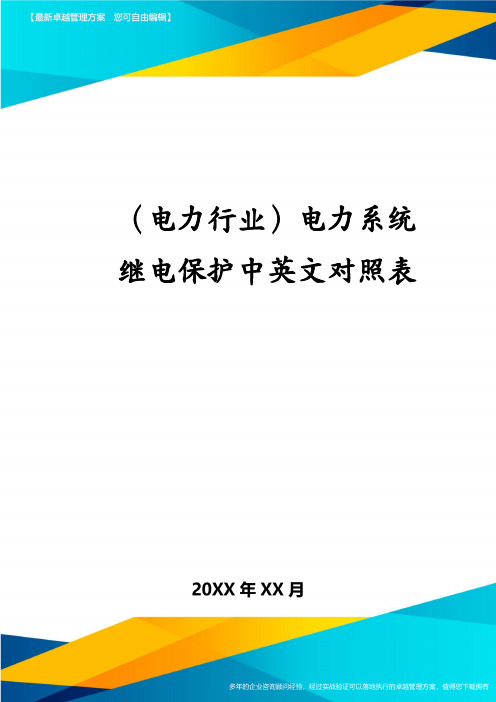
126Internalfault 内部故障 127Auxiliarycontacts 辅助触点 128Neutralauto-transformer 中性点接地自耦变压器 129Fusebox/fusiblecutout 熔断器 130Pulserelay/surgerelay 冲击继电器
旅长 2005 七 2007-10-2611:14
139Direct-to-groundcapacity 对地电容 140Shuntrunning 潜动 141Trip/opening 跳闸 142Tripswitch 跳闸开关 143Receivermachine 收信机 144High-frequencydirectionfinder 高频测向器 145Capacitycharge 电容充电 146timeover-current 时限过电流 148Surgeguard 冲击防护 149Oscillatorysurge 振荡冲击 150Failsafeinterlock 五防装置 151Differentialmotion 差动 152Capacitivecurrent 电容电流 154Timedelay 延时 156Normalinverse
Businsulator 母线绝缘器 62 Busrequestcycle 总线请求周期 63 Busreactor 母线电抗器 64 Busprotection 母线保护 65 Busrings 集电环 66 Busrod 汇流母线 67 Bussectionreactor 分段电抗器 68 Busstructure 母线支架;总线结构 69 Bustieswitch 母线联络开关 70 Bus-barchamber 母线箱
线圈调节器 81 Coilcurl 线圈 82 Coilcurrent 线圈电流 83 Coilendleakagereactance 线圈端漏电抗 84 Coilinductance 线圈电感 85 Currenttransformerphaseangle 电流互感器相角 86 Distancerelay;impedancerelay 阻抗继电器 87 Powerrheostat 电力变阻器 88 Electricallyoperatedvalve 电动阀门 89 Electricalgoverningsystem 电力调速系统 90
尼泊尔电压标准

尼泊尔电压标准尼泊尔,位于亚洲的喜马拉雅山脉南麓,以其壮丽的自然景观和悠久的历史文化而著名。
然而,对于许多游客和商务旅行者来说,一个值得关注的问题是尼泊尔的电压标准。
尼泊尔的电压标准是多少?这个问题对于计划前往尼泊尔的人来说至关重要。
尼泊尔的电压标准是220伏特,50赫兹。
这与欧洲大陆和亚洲大部分国家的电压标准相同。
然而,与美洲地区和其他一些国家的电压标准不同。
因此,如果你计划前往尼泊尔,并且需要使用电子设备,例如充电器、电脑、手机等,你必须确保你的设备支持220伏特的电压。
否则,你将需要一个电压转换器来适应尼泊尔的电网。
尼泊尔的电压标准源于其所在地区的电力发展历史和国际标准的统一。
尼泊尔并不是一个发达国家,电力供应还存在一些问题。
然而,尼泊尔政府一直在努力改善电力供应,以满足国内外需求。
尼泊尔的电力系统主要由国家电网公司(NEA)管理。
NEA负责供电、输电和配电工作。
尼泊尔的电力系统主要由水电和热能发电站提供电力。
尼泊尔位于喜马拉雅山脉,拥有丰富的水资源,因此水电是尼泊尔主要的清洁能源之一。
尼泊尔政府也积极发展其他可再生能源,例如太阳能和风能,以减少对进口能源的依赖。
尼泊尔的电力供应在城市和农村地区之间存在差异。
尽管尼泊尔政府一直在努力改善农村地区的电力供应,但由于地理条件和经济限制,一些偏远地区仍然面临电力供应不足的问题。
因此,如果你计划前往尼泊尔的边远地区,你可能需要做好无电或电力不稳定的准备。
尼泊尔的电压标准对于旅客和商务旅行者来说至关重要。
如果你计划前往尼泊尔,你应该确保你的电子设备支持220伏特的电压。
否则,你需要购买一个电压转换器,以适应尼泊尔的电网。
此外,你还应该了解尼泊尔的电力供应状况,特别是如果你计划前往农村地区。
总而言之,尼泊尔的电压标准是220伏特,50赫兹。
尽管尼泊尔的电力供应还存在一些问题,但尼泊尔政府一直在努力改善电力供应,以满足国内外需求。
如果你计划前往尼泊尔,你应该确保你的电子设备支持尼泊尔的电压标准,并了解尼泊尔的电力供应状况。
电力系统英文单词精编版

电力系统英文单词精编版MQS system office room 【MQS16H-TTMS2A-MQSS8Q8-MQSH16898】电力系统powersystem发电机generator励磁excitation励磁器excitor电压voltage电流current升压变压器step-uptransformer母线bus变压器transformer空载损耗no-loadloss铁损ironloss铜损copperloss空载电流no-loadcurrent有功损耗activeloss无功损耗reactiveloss输电系统powertransmissionsystem 高压侧highside输电线transmissionline高压highvoltage低压lowvoltage中压middlevoltage功角稳定anglestability稳定stability电压稳定voltagestability暂态稳定transientstability 电厂powerplant能量输送powertransfer交流AC直流DC电网powersystem落点droppoint开关站switchstation调节regulation高抗highvoltageshuntreactor 并列的apposable裕度margin故障fault三相故障threephasefault分接头tap切机generatortriping高顶值highlimitedvalue 静态static(state)动态dynamic(state)机端电压控制AVR电抗reactance电阻resistance功角powerangle有功(功率)activepower 电容器Capacitor电抗器Reactor断路器Breaker电动机motor功率因数power-factor定子stator阻抗impedance功角power-angle电压等级voltagegrade有功负载:activeloadPLoad 无功负载reactiveload档位tapposition电阻resistor电抗reactance电导conductance电纳susceptance上限upperlimit下限lowerlimit正序阻抗positivesequenceimpedance 负序阻抗negativesequenceimpedance 零序阻抗zerosequenceimpedance无功(功率)reactivepower功率因数powerfactor无功电流reactivecurrent斜率slope额定rating变比ratio参考值referencevalue电压互感器PT分接头tap仿真分析simulationanalysis下降率drooprate传递函数transferfunction框图blockdiagram受端receive-side同步synchronization保护断路器circuitbreaker摇摆swing阻尼damping无刷直流电机BruslessDCmotor刀闸(隔离开关)Isolator机端generatorterminal变电站transformersubstation永磁同步电机Permanent-magnetSynchronismMotor异步电机AsynchronousMotor三绕组变压器three-columntransformerThrClnTrans 双绕组变压器double-columntransformerDblClmnTrans 固定串联电容补偿fixedseriescapacitorcompensation 双回同杆并架double-circuitlinesonthesametower单机无穷大系统onemachine-infinitybussystem励磁电流Magnetizingcurrent补偿度degreeofcompensation电磁场:Electromagneticfields失去同步lossofsynchronization装机容量installedcapacity无功补偿reactivepowercompensation故障切除时间faultclearingtime极限切除时间criticalclearingtime强行励磁reinforcedexcitation并联电容器shuntcapacitor<下降特性droopcharacteristics线路补偿器LDC(linedropcompensation)电机学ElectricalMachinery自动控制理论AutomaticControlTheory电磁场ElectromagneticField微机原理PrincipleofMicrocomputer电工学Electrotechnics电路原理Principleofcircuits电机学ElectricalMachinery电力系统稳态分析Steady-StateAnalysisofPowerSystem电力系统暂态分析Transient-StateAnalysisofPowerSystem电力系统继电保护原理PrincipleofElectricalSystem'sRelayProtection电力系统元件保护原理ProtectionPrincipleofPowerSystem'sElement 电力系统内部过电压PastVoltagewithinPowersystem模拟电子技术基础BasisofAnalogueElectronicTechnique数字电子技术DigitalElectricalTechnique电路原理实验电气工程讲座Lecturesonelectricalpowerproduction电力电子基础Basicfundamentalsofpowerelectronics高电压工程Highvoltageengineering电子专题实践Topicsonexperimentalprojectofelectronics电气工程概论Introductiontoelectricalengineering电子电机集成系统Electronicmachinesystem电力传动与控制ElectricalDriveandControl电力系统继电保护PowerSystemRelayingProtection主变压器maintransformer升压变压器step-uptransformer降压变压器step-downtransformeroperatingtransformer备用变压器standbytransformer公用变压器commontransformer三相变压器three-phasetransformer单相变压器single-phasetransformer带负荷调压变压器on-loadregulatingtransformer 变压器铁芯transformercore变压器线圈transformercoil变压器绕组transformerwinding变压器油箱transformeroiltanktransformercasing变压器风扇transformerfan变压器油枕transformeroilconservator(∽drum 变压器额定电压transformerretedvoltage变压器额定电流transformerretedcurrent变压器调压范围transformervoltageregulationrage 配电设备powerdistributionequipmentSF6断路器SF6circuitbreaker开关switch按钮button隔离开关isolator,disconnector 真空开关vacuumswitch刀闸开关knife-switch接地刀闸earthingknife-switch 电气设备electricalequipment 变流器currentconverter电流互感器currenttransformer电压互感器voltagetransformer电源powersource交流电源ACpowersource直流电源DCpowersource 工作电源operatingsource 备用电源Standbysource 强电strongcurrent 弱电weakcurrent继电器relay信号继电器signalrelay电流继电器currentrelay电压继电器voltagerelay跳闸继电器trippingrelay合闸继电器closingrelay中间继电器intermediaterelay时间继电器timerelay零序电压继电器zero-sequencevoltagerelay 差动继电器differentialrelay闭锁装置lockingdevice遥控telecontrol遥信telesignalisation遥测telemetering遥调teleregulationbreaker,circuitbreaker少油断路器mini-oilbreaker,oil-mini-mumbreaker 高频滤波器high-frequencyfilter组合滤波器combinedfilter常开触点normallyopenedcontaact常闭触点normallyclosedcontaact并联电容parallelcapacitance保护接地protectiveearthing熔断器cutout,fusiblecutout电缆cabletrippingpulse合闸脉冲closingpulse一次电压primaryvoltage二次电压secondaryvoltage并联电容器parallelcapacitor无功补偿器reactivepowercompensationdevice 消弧线圈arc-suppressingcoil母线Bus,busbar三角接法deltaconnection星形接法Wyeconnectionschematicdiagram一次系统图primarysystemdiagram二次系统图secondarysystemdiagram两相短路two-phaseshortcircuit三相短路three-phaseshortcircuit单相接地短路single-phasegroundshortcircuit 短路电流计算calculationofshortcircuitcurrent 自动重合闸automaticreclosing高频保护high-freqencyprotection距离保护distanceprotectiontransversedifferentialprotection 纵差保护longitudinaldifferentialprotection 线路保护lineprotection过电压保护over-voltageprotection母差保护busdifferentialprotection瓦斯保护Buchholtzprotection变压器保护transformerprotection电动机保护motorprotection远方控制remotecontrol用电量powerconsumption载波carrier故障fault选择性selectivity速动性speed灵敏性sensitivity可靠性reliability电磁型继电器electromagnetic无时限电流速断保护instantaneouslyover-currentprotection 跳闸线圈tripcoil工作线圈operatingcoil制动线圈retraintcoil主保护mainprotection后备保护back-upprotection定时限过电流保护definitetimeover-currentprotection 三段式电流保护thecurrentprotectionwiththreestages 反时限过电流保护inversetimeover-currentprotection 方向性电流保护thedirectionalcurrentprotection零序电流保护zero-sequencecurrentprotection阻抗impedance微机保护MicroprocessorProtection。
电力系统中英文翻译
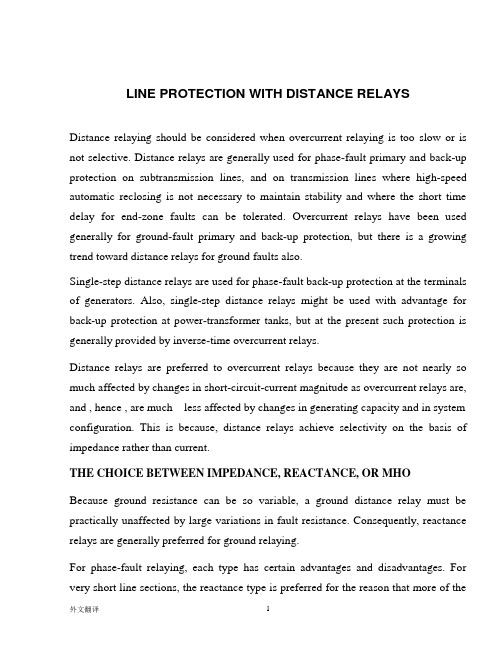
LINE PROTECTION WITH DISTANCE RELAYSDistance relaying should be considered when overcurrent relaying is too slow or is not selective. Distance relays are generally used for phase-fault primary and back-up protection on subtransmission lines, and on transmission lines where high-speed automatic reclosing is not necessary to maintain stability and where the short time delay for end-zone faults can be tolerated. Overcurrent relays have been used generally for ground-fault primary and back-up protection, but there is a growing trend toward distance relays for ground faults also.Single-step distance relays are used for phase-fault back-up protection at the terminals of generators. Also, single-step distance relays might be used with advantage for back-up protection at power-transformer tanks, but at the present such protection is generally provided by inverse-time overcurrent relays.Distance relays are preferred to overcurrent relays because they are not nearly so much affected by changes in short-circuit-current magnitude as overcurrent relays are, and , hence , are much less affected by changes in generating capacity and in system configuration. This is because, distance relays achieve selectivity on the basis of impedance rather than current.THE CHOICE BETWEEN IMPEDANCE, REACTANCE, OR MHOBecause ground resistance can be so variable, a ground distance relay must be practically unaffected by large variations in fault resistance. Consequently, reactance relays are generally preferred for ground relaying.For phase-fault relaying, each type has certain advantages and disadvantages. For very short line sections, the reactance type is preferred for the reason that more of theline can be protected at high speed. This is because the reactance relay is practically unaffected by arc resistance which may be large compared with the line impedance, as described elsewhere in this chapter. On the other hand, reactance-type distance relays at certain locations in a system are the most likely to operate undesirably on severe synchronizing-power surges unless additional relay equipment is provided to prevent such operation.The mho type is best suited for phase-fault relaying for longer lines, and particularly where severe synchronizing-power surges may occur. It is the least likely to require additional equipment to prevent tripping on synchronizing-power surges. When mho relaying is adjusted to protect any given line section, its operating characteristic encloses the least space on the R-X diagram, which means that it will be least affected by abnormal system conditions other than line faults; in other words, it is the most selective of all distance relays. Because the mho relay is affected by arc resistance more than any other type, it is applied to longer lines. The fact that it combines both the directional and the distance-measuring functions in one unit with one contact makes it very reliable.The impedance relay is better suited for phase-fault relaying for lines of moderate length than for either very short or very long lines. Arcs affect an impedance relay more than a reactance relay but less than a mho relay. Synchronizing-power surges affect an impedance relay less than a reactance relay but more than a mho relay. If an impedance-relay characteristic is offset, so as to make it a modified• relay, it can be made to resemble either a reactance relay or a mho relay but it will always require a separate directional unit.There is no sharp dividing line between areas of application where one or another type of distance relay is best suited. Actually, there is much overlapping of these areas. Also, changes that are made in systems, such as the addition of terminals to a line, can change the type of relay best suited to a particular location. Consequently, to realizethe fullest capabilities of distance relaying, one should use the type best suited for each application. In some cases much better selectivity can be obtained between relays of the same type, but, if relays are used that are best suited to each line, different types on adjacent lines have no appreciable adverse effect on selectivity. THE ADJUSTMENT OF DISTANCE RELAYSPhase distance relays are adjusted on the basis of the positive-phase-sequence impedance between the relay location and the fault location beyond which operation of a given relay unit should stop. Ground distance relays are adjusted in the same way, although some types may respond to the zero-phase-sequence impedance. This impedance, or the corresponding distance, is called the "reach" of the relay or unit. For purposes of rough approximation, it is customary to assume an average positive-phase-sequence-reactance value of about 0.8 ohm per mile for open transmission-line construction, and to neglect resistance. Accurate data are available in textbooks devoted to power-system analysis.To convert primary impedance to a secondary value for use in adjusting a phase or ground distance relay, the following formula is used:where the CT ratio is the ratio of the high-voltage phase current to the relay phase current, and the VT ratio is the ratio of the high-voltage phase-to-phase voltage to the relay phase-to-phase voltage–all under balanced three-phase conditions. Thus, for a 50-mile, 138-kv line with 600/5 wye-connected CT’s, the secondary positive-phase-sequence reactance is aboutIt is the practice to adjust the first, or high-speed, zone of distance relays to reach to80% to 90% of the length of a two-ended line or to 80% to 90% of the distance to the nearest terminal of a multiterminal line. There is no time-delay adjustment for this unit.The principal purpose of the second-zone unit of a distance relay is to provide protection for the rest of the line beyond the reach of the first-zone unit. It should be adjusted so that it will be able to operate even for arcing faults at the end of the line. To do this, the unit must reach beyond the end of the line. Even if arcing faults did not have to be considered, one would have to take into account an underreaching tendency because of the effect of intermediate current sources, and of errors in: (1) the data on which adjustments are based, (2) the current and voltage transformers, and (3) the relays. It is customary to try to have the second-zone unit reach to at least 20% of an adjoining line section; the farther this can be extended into the adjoining line section, the more leeway is allowed in the reach of the third-zone unit of the next line-section back that must be selective with this second-zone unit.The maximum value of the second-zone reach also has a limit. Under conditions of maximum overreach, the second-zone reach should be short enough to be selective with the second-zone units of distance relays on the shortest adjoining line sections, as illustrated in Fig. 1. Transient overreach need not be considered with relays having a high ratio of reset to pickup because the transient that causes overreach will have expired before the second-zone tripping time. However, if the ratio of reset to pickup is low, the second-zone unit must be set either (1) with a reach short enough so that its overreach will not extend beyond the reach of the first-zone unit of the adjoining linesection under the same conditions, or (2) with a time delay long enough to be selective with the second-zone time of the adjoining section, as shown in Fig. 2. In this connection, any underreaching tendencies of the relays on the adjoining line sections must be taken into account. When an adjoining line is so short that it is impossible to get the required selectivity on the basis of react, it becomes necessary to increase the time delay, as illustrated in Fig. 2. Otherwise, the time delay of the second-zone unit should be long enough to provide selectivity with the slowest of (1) bus-differential relays of the bus at the other end of the line(2)transformer-differential relays of transformers on the bus at the other end of the line,or (3) line relays of adjoining line sections. The interrupting time of the circuit breakers of these various elements will also affect the second-zone time. This second-zone time is normally about 0.2 second to 0.5 second.The third-zone unit provides back-up protection for faults in adjoining line sections.So far as possible, its reach should extend beyond the end of the longest adjoining line section under the conditions that cause the maximum amount of underreach, namely, arcs and intermediate current sources. Figure 3 shows a normal back-up characteristic. The third-zone time delay is usually about 0.4 second to 1.0 second. To reach beyond the end of a long adjoining line and still be selective with the relays of a short line, it may be necessary to get this selectivity with additional time delay, as in Fig. 4.THE EFFECT OF ARCS ON DISTANCE-RELAY OPERATIONThe critical arc location is just short of the point on a line at which a distance relay's operation changes from high-speed to intermediate time or from intermediate time to back-up time. We are concerned with the possibility that an arc within the high-speed zone will make the relay operate in intermediate time, that an arc within the intermediate zone will make the relay operate in back-up time, or that an arc within the back-up zone will prevent relay operation completely. In other words, the effect of an arc may be to cause a distance relay to underreach.For an arc just short of the end of the first- or high-speed zone, it is the initial characteristic of the arc that concerns us. A distance relay's first-zone unit is so fast that, if the impedance is such that the unit can operate immediately when the arc is struck, it will do so before the arc can stretch appreciably and thereby increase itsresistance. Therefore, we can calculate the arc characteristic for a length equal to the distance between conductors for phase-to-phase faults, or across an insulator string for phase-to-ground faults. On the other hand, for arcs in the intermediate-time or back-up zones, the effect of wind stretching the arc should be considered, and then the operating time for which the relay is adjusted has an important bearing on the outcome.Tending to offset the longer time an arc has to stretch in the wind when it is in the intermediate or back-up zones is the fact that, the farther an arcing fault is from a relay, the less will its effect be on the relay's operation. In other words, the more line impedance there is between the relay and the fault, the less change there will be in the total impedance when the arc resistance is added. On the other hand, the farther away an arc is, the higher its apparent resistance will be because the current contribution from the relay end of the line will be smaller, as considered later.A small reduction in the high-speed-zone reach because of an arc is objectionable, but it can be tolerated if necessary. One can always use a reactance-type or modified-impendance type distance relay to minimize such reduction. The intermediate-zone reach must not be reduced by an arc to the point at which relays of the next line back will not be selective; of course, they too will be affected by the arc, but not so much. Reactance-type or modified-impendance-type distance relays are useful here also for assuring the minimum reduction in second-zone reach. Figure 5 shows how an impedance or mho characteristic can be offset to minimize its susceptibility to an arc. One can also help the situation by making the second-zone reach as long as possible so that a certain amount of reach reduction by an arc is permissible. Conventional relays do not use the reactance unit for the back-up zone; instead, they use either an impedance unit, a modified-impendance unit, or a mho unit. If failure of the back-up unit to operate because of an arc extended by the wind is a problem, the modified-impendance unit can be used or the mho–or "starting"–unitcharacteristic can also be shifted to make its operation less affected by arc resistance. The low-reset characteristic of some types of distance relay is advantageous in preventing reset as the wind stretches out an arc.Although an arc itself is practically all resistance, it may have a capacitive-reactance or an inductive-reactance component when viewed from the end of a line where the relays are. The impedance of an arc (ZA) has the appearance:where I1 = the complex expression for the current flowing into the arc from the end of the line where the relays under consideration are.I2= the complex expression for the current flowing into the arc from the other end of the line.R A = the arc resistance with current (I1 + I2) flowing into it.Of more practical significance is the fact that, as shown by the equation, the arc resistance will appear to be higher than it actually is, and it may be very much higher. After the other end of the line trips, the arc resistance will be higher because the arccurrent will be lower. However, its appearance to the relays will no longer be magnified, because I2 will be zero. Whether its resistance will appear to the relays to be higher or lower than before will depend on the relative and actual magnitudes of the currents before and after the distant breaker opens.输电线路的距离保护在过电流保护灵敏度低或选择性差时,应当考虑采用距离保护。
尼泊尔电力市场前景概况

上年 增 长约 9 %, 其 中 电 网可 提供 电力 7 1 9 . 6 MW ,
其余 3 3 5 M W 无 法满 足 。 同 时 ,尼 泊 尔 电 力 系 统 电 量 需 求 达 到 5 4 4 6 . 2 8 5 G W・ h , 比上年 增 长约 7 . 7 %, 其中 , 电 网
表 1 尼 泊 尔 水 力 资 源 分 布 M W
尼泊 尔未 来经 济 的发展进 程 。 尼泊尔为南 亚山区 内陆 国家 , 位于喜 马拉雅 山南
麓, 北邻 中国西 藏 自治 区 , 其余 三面 与 印度接 壤 。 国
境线长 3 1 0 0 k m, 国土 面积 l 4 . 7 2万 k m 。境 内山峦
摘要 : 尼 泊 尔拥 有 丰 富 的 水 力 资 源 , 其 理 论 蕴藏 量 约 8 3 0 0 0 M w, 其 中技 术 可 开发 量 约 4 2 0 0 0 MW , 截
至2 0 1 2 / 1 3财政 年 年底 , 尼 泊 尔 已建 电站 总装 机 容 量 达 7 6 2 M W, 仅 占技 术 可 开 发 量 的 1 . 8 %, 开发潜 力 巨
2 0 1 4年 8月 文章 编 号 : 1 0 0 6 - 0 0 8 1 ( 2 0 1 4 ) 0 8 - 0 0 3 4 - 0 4
水 利 水 电 快 报 E WR H I
第3 5卷 第 8期
尼 泊 尔 电 力 市 场 前 景 概 况
毕 小 剑 杨 婷
( 中国水 电顾 问集 团西北 勘 测设计 研 究院 , 陕西 西 安 7 1 0 0 6 5 )
1 概 述
尼泊 尔 水能 资 源 极其 丰富 , 但 其 目前 的 开 发程
度和 利用 水平还 很 低 , 无 法 满 足 国 民经 济 发 展 和人 民生 活所需 , 水 电行 业 的供求 矛盾 随着 国民 经 济 的
尼泊尔MCC协议具体内容
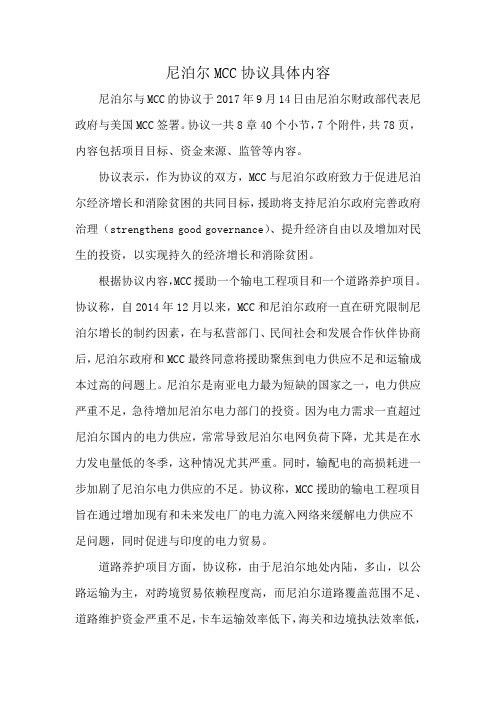
尼泊尔MCC协议具体内容尼泊尔与MCC的协议于2017年9月14日由尼泊尔财政部代表尼政府与美国MCC签署。
协议一共8章40个小节,7个附件,共78页,内容包括项目目标、资金来源、监管等内容。
协议表示,作为协议的双方,MCC与尼泊尔政府致力于促进尼泊尔经济增长和消除贫困的共同目标,援助将支持尼泊尔政府完善政府治理(strengthens good governance)、提升经济自由以及增加对民生的投资,以实现持久的经济增长和消除贫困。
根据协议内容,MCC援助一个输电工程项目和一个道路养护项目。
协议称,自2014年12月以来,MCC和尼泊尔政府一直在研究限制尼泊尔增长的制约因素,在与私营部门、民间社会和发展合作伙伴协商后,尼泊尔政府和MCC最终同意将援助聚焦到电力供应不足和运输成本过高的问题上。
尼泊尔是南亚电力最为短缺的国家之一,电力供应严重不足,急待增加尼泊尔电力部门的投资。
因为电力需求一直超过尼泊尔国内的电力供应,常常导致尼泊尔电网负荷下降,尤其是在水力发电量低的冬季,这种情况尤其严重。
同时,输配电的高损耗进一步加剧了尼泊尔电力供应的不足。
协议称,MCC援助的输电工程项目旨在通过增加现有和未来发电厂的电力流入网络来缓解电力供应不足问题,同时促进与印度的电力贸易。
道路养护项目方面,协议称,由于尼泊尔地处内陆,多山,以公路运输为主,对跨境贸易依赖程度高,而尼泊尔道路覆盖范围不足、道路维护资金严重不足,卡车运输效率低下,海关和边境执法效率低,这限制了尼泊尔经济的发展。
根据协议,MCC将向尼政府提供不超过4.595亿美元实施这两项援助。
此外,还将向尼政府提供4050万美元管理费用供政府用于推动援助项目的实施。
协议也规定,尼泊尔政府不得对MCC提供的援助资金征收任何现有或未来的各种税款,包括海关关税,援助资金不得用于任何违反美国法律或政策的用途,如协助或训练军队、警察、民兵、国民警卫队或其他准军事组织或单位,可能导致美国工作岗位大量流失或美国生产大量转移的活动,以其他方式支持任何可能导致重大环境、健康或安全危害的活动,为实施堕胎支付费用或激励或强迫任何人进行堕胎等。
全球电网信息汇总
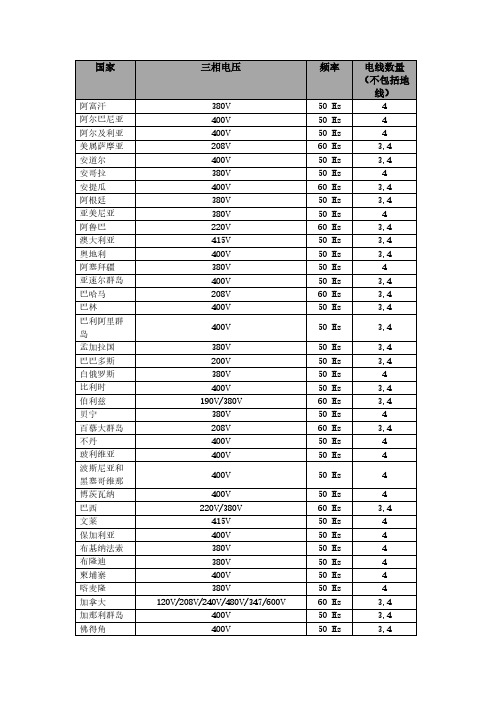
频率
50 Hz 50 Hz 50 Hz 60 Hz 50 Hz 50 Hz 60 Hz 50 Hz 50 Hz 60 Hz 50 Hz 50 Hz 50 Hz 50 Hz 60 Hz 50 Hz
380V 400V 220V/380V 400V 400V 415V 400V 380V 400V 380V 220V 400V 220V/480V 380V 400V 400V 400V 400V 380V 380V 400V 380V 415V 400V 400V
220V/380V
380V
400V 208V 380V 400V 230V/400V 415V 400V 208V 240V
三相电压
380V 400V 400V 208V 400V 380V 400V 380V 380V 220V 415V 400V 380V 400V 208V 400V
400V
380V 200V 380V 400V 190V/380V 380V 208V 400V 400V
400V
400V 220V/380V
4
50 Hz
4
60 Hz
3,4
50 Hz
4
50 Hz
4
50 Hz
4
50 Hz
4
澳门 马其顿 马达加斯加 马德拉 马拉维 马来西亚 马尔代夫 马里 马耳他 马提尼克 毛里塔尼亚 毛里求斯 墨西哥 摩尔多瓦 摩纳哥 蒙古 黑山 蒙特塞拉特 摩洛哥 莫桑比克 缅甸 纳米比亚 瑙鲁 尼泊尔 荷兰 荷属安的列 斯群岛 新喀里多尼 亚 新西兰 尼加拉瓜 尼日尔 尼日利亚 挪威 阿曼 巴基斯坦 帕劳 巴拿马 巴布亚新几 内亚 巴拉圭 秘鲁 菲律宾
电力系统继电保护外文及翻译演示教学
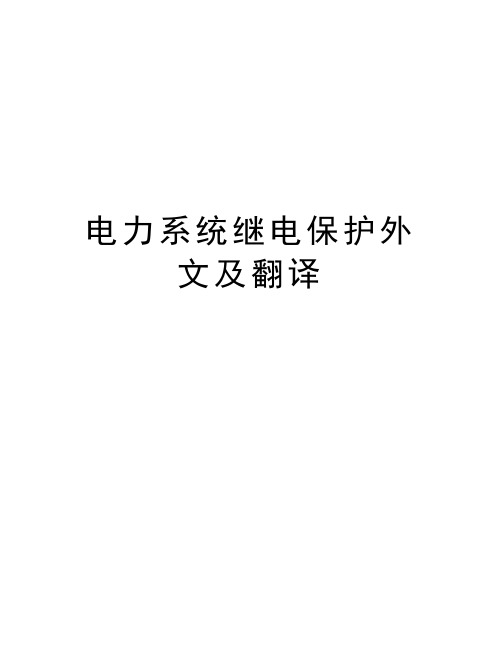
电力系统继电保护外文及翻译Power System ProtectionsThe steady-state operation of a power system is frequently disturbed by various faults on electrical equipment. To maintain the proper operation of the power system, an effective, efficient and reliable protection scheme is required. Power system components are designed to operate under normal operating conditions.However, due to any reason, say a fault, there is an abnormality, it is necessary that there should be a device which senses these abnormal conditions and if so, the element or component where such an abnormality has taken place is removed, i.e. deleted from the rest of the system as soon as possible. This is necessary because the power system component can never be designed to withstand the worst possible conditions due to the fact that this will make the whole system highly uneconomical. And therefore, if such an abnormality takes place in any element or component of the power system network, it is desirable that the affected element/component is removed from the rest of the system reliably and quickly in order to restore power in the remaining system under the normal condition as soon as possible.The protection scheme includes both the protective relays and switching circuits, i.e. circuit breakers. The protective relay which functions as a brain is a very important component. The protective relay is a sensing device, which senses the fault, determines its location and then sends command to the proper circuit breaker by closing its trip coil. The circuit breaker after getting command from the protective relay disconnects only the faulted element. this is why the protective relay must be reliable, maintainable and fast in operation.In early days, there used to be electromechanical relay of induction disk-type.However, very soon the disk was replaced by inverted cup, i.e.hollow cylinder and the new relay obtained was known as an induction cup or induction cylinder relay. This relay, which is still in use, possesses several important features such as higher speed; higher torque for a given power input an more uniform torque.However, with the advent of electronic tubes, electronic relays having distinct features were developed during 1940s. With the discovery of solid state components during 1950s, static relays with numerous advantages were developed. The use of digital computers for protective relaying purposes has been engaging the attention of research and practicing engineers since layer 1960s and 1980s. Now, the microprocessor/mini computer-based relaying scheme, because of its numerous advantages such as self –checking feature and flexibility, has been widely used in power system all over the world.The overall system protection is divided into following sections: (i)Generator protection,(ii)Transformer protection,(iii)Bus protection,(iv)Feederprotection,(v)Transmission line protection.Basic Requirements to Protective RelaysAny protection scheme, which i.e. required to safeguard the power system components against abnormal conditions such as faults, consists basically of two elements(i)Protective relay and (ii) Circuit breaker .The protective relay which is primarily the brain behind the whole scheme plays a very important role. Therefore proper care should be taken in selecting an appropriate protective relay which is reliable, efficient and fast in operation. The protective relay must satisfy the following requirements:⑴ since faults on a well designed and healthy system are normally rare, therelays are called upon to operate only occasionally. This means that therelaying scheme is normally idle and must operate whenever fault occurs. Inother words, it must be reliable.⑵ Since the reliability partly depends upon the maintenance, the relay mustbe easily maintainable.⑶ The palpation of the relay can be in two ways. One is the failure to operatein case a fault occurs an second is the relay operation when there is no fault.As a matter of fact, relay must operate if there is a fault and must notoperate if there is no fault.⑷Relaying scheme must be sensitive enough to distinguish between normaland the faulty system.Protective RelaysThe function of the protective relay is to sense the fault and energize the tripcoil of the circuit breaker. The following types of the protective relays are usedfor the apparatus such as synchronous machines, bus bar, transformer and theother apparatus and transmission line protection.(1) Over current relays,(2) Under voltage relays,(3) Under frequency relays,(4) Directional relays,(5) Thermal relays,(6) Phase sequence relays such as(i)negative sequence relays and, (ii)zerosequence relays,(7) Differential relays and percentage differential relays,(8) Distance relays such as (I)plane impedance relays,(ii)angle impedance relay,i.e. Ohm or reactance relays,(iii)angle admittance relays,i.e. Mho relaysand ,(iv)offset and restricted relays,(9)Pilot relays such as (i) wire pilot relays,(ii)carrier channel pilotrelays,(iii)microwave pilot relays. There are different types of the relayingscheme based on construction. They are:(i)electromechanicaltype,(ii)thermal relays,(iii) transduction relays,(iv)rectifier bridgerelay,(v)electronic relays,(vi)digital relaying schemes.电力系统继电保护电力系统的稳态运行经常会因各种电力设备配故障原因而被扰乱。
尼泊尔电力市场及投资环境分析
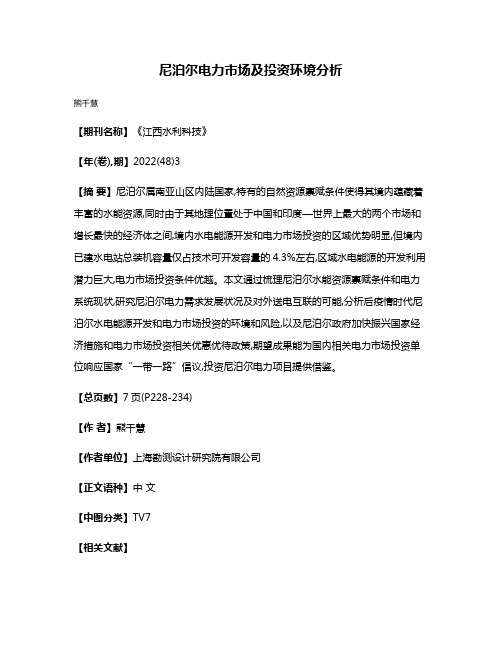
尼泊尔电力市场及投资环境分析
熊千慧
【期刊名称】《江西水利科技》
【年(卷),期】2022(48)3
【摘要】尼泊尔属南亚山区内陆国家,特有的自然资源禀赋条件使得其境内蕴藏着丰富的水能资源,同时由于其地理位置处于中国和印度—世界上最大的两个市场和增长最快的经济体之间,境内水电能源开发和电力市场投资的区域优势明显,但境内已建水电站总装机容量仅占技术可开发容量的4.3%左右,区域水电能源的开发利用潜力巨大,电力市场投资条件优越。
本文通过梳理尼泊尔水能资源禀赋条件和电力系统现状,研究尼泊尔电力需求发展状况及对外送电互联的可能,分析后疫情时代尼泊尔水电能源开发和电力市场投资的环境和风险,以及尼泊尔政府加快振兴国家经济措施和电力市场投资相关优惠优待政策,期望成果能为国内相关电力市场投资单位响应国家“一带一路”倡议,投资尼泊尔电力项目提供借鉴。
【总页数】7页(P228-234)
【作者】熊千慧
【作者单位】上海勘测设计研究院有限公司
【正文语种】中文
【中图分类】TV7
【相关文献】
1."一带一路",向南美延伸r——厄瓜多尔国家电力投资市场环境分析
2.哈萨克斯坦贸易投资环境分析——中国企业在哈国市场的投资贸易指南
3.投资环境分析新思路--原有投资环境分析弊端和投资环境分析新方法综说
4.中国企业投资开发尼泊尔电力市场的调研分析
5.尼泊尔电力市场及国际电力互联分析
因版权原因,仅展示原文概要,查看原文内容请购买。
尼泊尔电力市场分析

邻。尼泊尔对于中印两国来说,战略位置都非常重要,与尼
泊尔保持友好合作关系对维护我国边疆地区稳定非常重要。
近年来,尼中两国的贸易额增速是其与印度贸易额增速的 17
倍,中国也在去年取代印度成为尼泊尔最大的海外投资国。
20
中国水运
第 21 卷
世行逐年重视并大力支持尼泊尔水电开发,积极推动中 印合作开发尼泊尔水电市场。水电被列为尼泊尔国家经济发 展和援助的第一资源。亚洲开发银行通过发展电力、交通、 基础设施、教育、农业等支持尼泊尔经济发展。
(MW)
电力盈亏
4 (MW) 270 -593 -3,209 287 -572 -3,186 494
备用率 25%
备注
加()的数值为缺乏,不加则为盈余;
四、电力投资环境分析
3,115 492 721 478 2,394 14
-398 -3,020
1.地缘政治
尼泊尔是世界上最不发达的国家之一,与中、印两国为
图 3 尼泊尔电网示意图 三、电力市场空间分析 1.尼泊尔电力市场空间分析 尼泊尔国内现状缺电严重,电力供需矛盾突出,供电可 靠性低,不利于电网的安全稳定运行,且每日都需拉闸限电, 最长日停电时间达 3h。 至规划水平 年 2025 年最大电力缺口约 为 593MW
(19.1%),仍有电力缺口,需进一步规划建设调节能力较高
富地区。根据 2018 年 AEPC 风能和太阳能评估数据,尼泊 尔具有经济性且接入电网的太阳能资源可达到 2,100MW。 尼泊尔风能资源一般,大部分区域 100m 高度的风速在 5m/s 以下。
因此尼泊尔的核心还是水能资源,为第一战略资源。 二、尼泊尔电力系统现状及发展规划 1.尼泊尔电力系统现状 (1)电源现状 尼泊尔电源基本为水电,仅有少量火电(柴油发电)和 太阳能电站。截止 2019 年 7 月 2 日,尼泊尔电力发展署 (Department of Electricity Development,DoED)管 理口径总装机容量为 1,101.7MW,其中,水电总装机容量 1,047MW,占比约 95.03%,除库尼卡尼一期(60MW) 和二期(32MW)电站外,其余都是径流式电站,径流式水 电站占比 91.6%,旱季电力严重不足,电力供需矛盾突出, 供电可靠性低。火电总装机容量 53.4MW,占比约 4.82%; 太阳能 1.7MW,占比约 0.15%。
尼泊尔电力系统状况--中英文
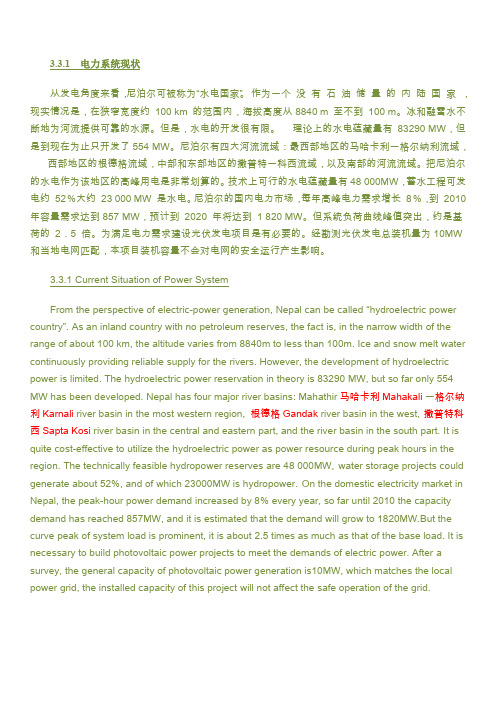
3.3.1 电力系统现状从发电角度来看,尼泊尔可被称为“水电国家”。
作为一个没有石油储量的内陆国家,现实情况是,在狭窄宽度约100 km 的范围内,海拔高度从8840 m 至不到100 m。
冰和融雪水不断地为河流提供可靠的水源。
但是,水电的开发很有限。
理论上的水电蕴藏量有83290 MW,但是到现在为止只开发了554 MW。
尼泊尔有四大河流流域:最西部地区的马哈卡利一格尔纳利流域,西部地区的根德格流域,中部和东部地区的撒普特一科西流域,以及南部的河流流域。
把尼泊尔的水电作为该地区的高峰用电是非常划算的。
技术上可行的水电蕴藏量有48 000MW,蓄水工程可发电约52%大约23 000 MW 是水电。
尼泊尔的国内电力市场,每年高峰电力需求增长8%,到2010 年容量需求达到857 MW,预计到2020 年将达到1 820 MW。
但系统负荷曲线峰值突出,约是基荷的2.5 倍。
为满足电力需求建设光伏发电项目是有必要的。
经勘测光伏发电总装机量为10MW 和当地电网匹配,本项目装机容量不会对电网的安全运行产生影响。
3.3.1 Current Situation of Power SystemFrom the perspective of electric-power generation, Nepal can be called “hydroelectric power country”. As an inland country with no petroleum reserves, the fact is, in the narrow width of the range of about 100 km, the altitude varies from 8840m to less than 100m. Ice and snow melt water continuously providing reliable supply for the rivers. However, the development of hydroelectric power is limited. The hydroelectric power reservation in theory is 83290 MW, but so far only 554 MW has been developed. Nepal has four major river basins: Mahathir马哈卡利Mahakali一格尔纳利Karnali river basin in the most western region, 根德格Gandak river basin in the west,撒普特科西Sapta Kosi river basin in the central and eastern part, and the river basin in the south part. It is quite cost-effective to utilize the hydroelectric power as power resource during peak hours in the region. The technically feasible hydropower reserves are 48 000MW,water storage projects could generate about 52%, and of which 23000MW is hydropower.On the domestic electricity market in Nepal, the peak-hour power demand increased by 8% every year, so far until 2010 the capacity demand has reached 857MW, and it is estimated that the demand will grow to 1820MW.But the curve peak of system load is prominent, it is about 2.5 times as much as that of the base load. It is necessary to build photovoltaic power projects to meet the demands of electric power. After a survey, the general capacity of photovoltaic power generation is10MW, which matches the local power grid, the installed capacity of this project will not affect the safe operation of the grid.。
尼泊尔英文

尼泊尔英文NepalIntroduction:Nepal is a landlocked country situated in South Asia. It is located in the Himalayas and shares borders with India to the south and Tibet to the north. Nepal is a country with rich diverse culture and natural beauty. The country is home to the world's highest mountain, Mount Everest, and also has many other peaks that are above 8,000 meters. It is a melting pot of various ethnic groups, languages, and religions, with Nepali being the official language.Geography:Nepal is a landlocked country that is squeezed between the high Himalayas in the north and the Indian plains in the south. The country has a total area of 147,181 square kilometers and is divided into three main geographical regions. The lowland Terai region in the south, the middle hilly region, and the high mountainous region in the north. The Terai region is the most fertile with subtropical forests, grasslands, and wildlife habitat. The hilly region consists of densely forested hills, terraced farmland, and ancient villages. The mountainous region contains some of the highest and most rugged peaks on earth, including Mount Everest.Culture and Religion:Nepal is a multicultural country with a diverse ethnic population. The population is composed of various groups, including the Brahmin and Chhetri, who are the upper caste people, and the Newars, who are the indigenous people of the Kathmandu valley. Other ethnic groups include the Tamang, Gurung, Magar, Tharu, and many others. Each group has its unique language, culture, and customs.The majority of the population practices Hinduism, followed by Buddhism. Other religions include Islam, Christianity, and Sikhism. Nepal is home tomany sacred temples and pilgrimage sites, including Pashupatinath Temple, Boudhanath Stupa, and Swayambhunath Stupa. These sites attract pilgrims and tourists from all over the world.Economy:Nepal is one of the poorest countries in Asia, with an economy heavily dependent on agriculture. The country is known for its production of rice, wheat, maize, and other crops. The agricultural sector employs more than 70% of the workforce in Nepal. The country's other major industries include tourism, manufacturing, construction, and forestry. Nepal's tourism industry is a significant contributor to the economy, with millions of tourists visiting the country each year to explore its natural beauty, trekking, and adventure tourism.Politics:Nepal is a federal democratic republic with an elected government. The President is the Head of State, and the Prime Minister is the Head of Government. Nepal adopted a new Constitution in 2015, which established a federal system of government with seven provinces. The country hasexperienced political instability and violence in recent years, including a decade-long Maoist insurgency that ended in 2006. Nepal is currently facing challenges of political stability and good governance.Tourism:Nepal is a popular tourist destination, famous for its natural beauty and adventure tourism. The country has many natural attractions, including the Himalayan range, national parks, rivers, lakes, and hot springs. Some of the famous trekking and mountaineering destinations include Annapurna Base Camp, Everest Base Camp, Mustang, and many other regions.Nepal is also famous for its cultural and historical sites, including the Kathmandu Durbar Square, the Bhaktapur Durbar Square, and the Patan Durbar Square. These sites showcase the unique architectural style of the Kathmandu valley.Conclusion:Nepal is a country with rich biodiversity, culture, and history. It is home to some of the highest peaks in the world and offers unique adventure tourism opportunities. The country's diverse ethnic groups, languages, and religions add to its charm and allure. Although Nepal faces many challenges, including poverty and political instability, the country's people remain resilient and continue to work towards a better future.。
尼泊尔水电发展概况

尼泊尔水电发展概况
赵鑫;马贵生
【期刊名称】《水利水电快报》
【年(卷),期】2014(035)007
【摘要】尼泊尔水电资源蕴藏量巨大,水力发电在电力行业占相当大的比重,但目前水电发展水平较低,电力供不应求.为此,该国正在寻求开发喜马拉雅地区水电资源.指出了水电开发中存在的主要问题,并对已建、在建的水电站,以及未来水电开发规划作了简要介绍.
【总页数】3页(P7-9)
【作者】赵鑫;马贵生
【作者单位】
【正文语种】中文
【中图分类】TV213
【相关文献】
1.国外水电发展概况及对我国水电发展的启示(七)——瑞士大坝安全管理与绿色水电认证
2.国外水电发展概况及对我国水电发展的启示(四)——瑞士水电发展及启示
3.国外水电发展概况及对我国水电发展的启示(五)——印度、越南水电发展及启示
4.中国水电:12亿签约尼泊尔最大水电工程
5.中国水电:签约尼泊尔最大水电工程
因版权原因,仅展示原文概要,查看原文内容请购买。
电力系统继电保护中英文对照表
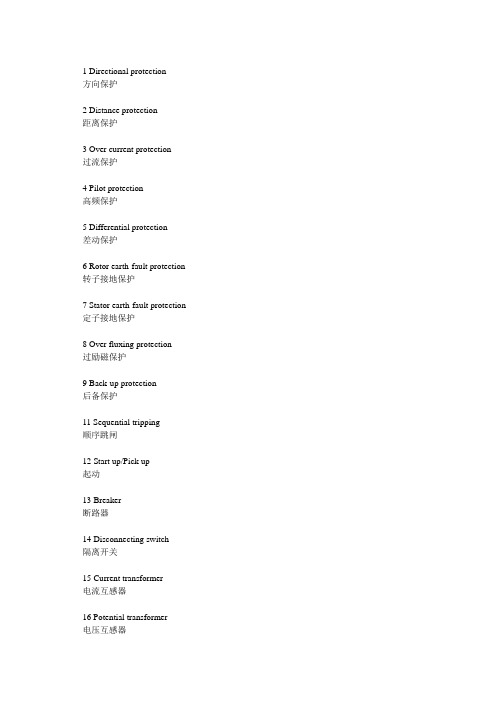
1 Directional protection方向保护2 Distance protection距离保护3 Over current protection过流保护4 Pilot protection高频保护5 Differential protection差动保护6 Rotor earth-fault protection 转子接地保护7 Stator earth-fault protection 定子接地保护8 Over fluxing protection过励磁保护9 Back-up protection后备保护11 Sequential tripping顺序跳闸12 Start up/Pick up起动13 Breaker断路器14 Disconnecting switch隔离开关15 Current transformer电流互感器16 Potential transformer电压互感器17 Dead zone/Blind spot死区18 Vibration/Oscillation振荡19 Reliability可靠性20 Sensitivity灵敏性21 Speed速动性22 Selectivity选择性23 Step-type distance relay分段距离继电器24 Time delay延时25 Escapement/interlock/blocking 闭锁26 Incorrect tripping误动27 Phase to phase fault相间故障28 Earth fault接地故障29 Through- fault穿越故障30 Permanent fault永久性故障31 Temporary fault瞬时性故障32 Overload过负荷34 Contact multiplying relay触点多路式继电器35 Timer relay时间继电器40 Ground fault relay接地故障继电器41 Recloser重合闸42 Zero-sequence protection零序保护43 Soft strap软压板44 Hard strap硬压板45 High resistance高阻46 Second harmonic escapement 二次谐波制动47 CT line-breakCT断线48 PT line-breakPT断线49 Secondary circuit二次回路50 AC circuit breaker交流开关电路51 AC directional over current relay 交流方向过流继电器52 Breaker point wrench开关把手53 Breaker trip coil断路器跳闸线圈54 Bus bar母线; 导电条55 Bus bar current transformer母线电流变压器56Bus bar disconnecting switch分段母线隔离开关57Bus compartment母线室; 汇流条隔离室58Bus duct母线槽; 母线管道59Bus hub总线插座60Bus line汇流线61Bus insulator母线绝缘器62Bus request cycle总线请求周期63Bus reactor母线电抗器64Bus protection母线保护65Bus rings集电环66Bus rod汇流母线67Bus section reactor分段电抗器68Bus structure母线支架; 总线结构69Bus tie switch母线联络开关70Bus-bar chamber母线箱71Bus-bar fault母线故障72Bus-bar insulator母线绝缘子73Busbar sectionalizing switch 母线分段开关74Current attenuation电流衰减75Current actuated leakage protector电流起动型漏电保护器76Current balance type current differential relay电流平衡式差动电流继电器;差动平衡式电流继电器77Current changer换流器78Current compensational ground distance relay电流补偿式接地远距继电器79Current consumption电流消耗80Coil adjuster线圈调节器81Coil curl线圈82Coil current线圈电流83Coil end leakage reactance线圈端漏电抗84Coil inductance线圈电感85Current transformer phase angle电流互感器相角86Distance relay; impedance relay阻抗继电器87Power rheostat电力变阻器88Electrically operated valve电动阀门89Electrical governing system电力调速系统90Field application relay励磁继电器; 激励继电器91High tension electrical porcelain insulator 高压电瓷绝缘子92Option board任选板; 选配电路板; 选择板93Oscillator coil振荡线圈94Over-V oltage relay过压继电器95Power factor relay功率因素继电器96Protection against overpressure超压防护97Protection against unsymmetrical load 不对称负载保护装置98Protection device保护设备; 防护设备99Protection reactor保护电抗器100Protection screen保护屏101Protection switch保护开关102Insulator cap绝缘子帽; 绝缘子帽103Insulator chain绝缘子串; 绝缘子串104Insulator arc-over绝缘子闪络; 绝缘子闪络105Insulator arcing horn绝缘子角形避雷器; 绝缘子角形避雷器106Insulator bracket绝缘子托架; 绝缘子托架107Impedance compensator阻抗补偿器108 Resistance grounded neutral system 中心点电阻接地方式109 Reactance bond电抗耦合; 接合扼流圈110 Reactance of armature reaction电枢反应电抗111 Under-Voltage relay欠压继电器112 V oltage differential relay电压差动继电器114 Relay must-operate value继电器保证启动值115 Relay act trip继电器操作跳闸116 Relay overrun继电器超限运行117 Longitudinal differential protection纵联差动保护118 Phase-angle of voltage transformer电压互感器的相角差119 Zero-sequence current/residual current 零序电流120 Residual current relay零序电流继电器121 Bus bar protection/bus protection母线保护122 Breaker contact point断路器触点123 Cut-off push断路器按钮124 Gaseous shield瓦斯保护装置125 Neutral-point earthing中性点接地126 Internal fault内部故障127 Auxiliary contacts辅助触点128 Neutral auto-transformer中性点接地自耦变压器129 Fuse box/fusible cutout熔断器130 Pulse relay/surge relay冲击继电器旅长2005131 Auxiliary relay/intermediate relay中间继电器132 Common-mode voltage共模电压133 Impedance mismatch阻抗失配134 Intermittent fillet weld间断角缝焊接135 Loss of synchronism protection失步保护136 Closing coil合闸线圈137 Electro polarized relay极化继电器138 Power direction relay功率方向继电器139 Direct-to-ground capacity对地电容140 Shunt running潜动141 Trip/opening跳闸142 Trip switch跳闸开关143 Receiver machine收信机144 High-frequency direction finder 高频测向器145 Capacity charge电容充电146 time over-current时限过电流148 Surge guard冲击防护149 Oscillatory surge振荡冲击150 Fail safe interlock五防装置151 Differential motion差动152 Capacitive current电容电流154 Time delay延时156 Normal inverse反时限157 Definite time定时限158 Multi-zone relay分段限时继电器159 Fail-safe unit五防161 Unbalance current不平衡电流162 Blocking autorecloser 闭锁重合闸163 Primary protection主保护164 Tap分接头165 YC (telemetering)遥测167 Fault clearing time故障切除时间168 Critical clearing time 极限切除时间169 Switch station开关站170 Traveling wave行波171 Protection feature保护特性172 Fault phase selector故障选线元件173 Fault type故障类型174 Inrush励磁涌流175 Ratio restrain比率制动176 Laplace and Fourier transforms 拉氏和傅利叶变换177 Short circuit calculations短路计算178 Load flow calculations潮流计算179 Oscillatory reactivity perturbation 振荡反应性扰动180 Quasi-steady state准稳态181 Automatic quasi-synchronization 自动准同步182 Protective relaying equipment继电保护装置183 AC directional overcurrent relay 交流方向过流继电器184 AC reclosing relay交流重合闸继电器185 Annunciator relay信号继电器188 Carrier or pilot-wire receiver relay载波或导引线接受继电器189 Current-limiting relay限流继电器190 Definite time relay定时限继电器192 Lockout relay闭锁继电器;保持继电器;出口继电器193 Micro-processor based protective relay 微机继电保护194 V oltage -controlled overcurrent relay 电压控制过电流继电器196 Fault diagnosis故障诊断197 Back-up protection后备保护198 Overhead line架空线199 High voltage line高压线路200 Underground cable埋地电缆201 Circuit breaker断路器202 Brushless excitation无刷励磁203 Interlock闭锁204 Trigger触发器205 Winding-to-winding insulation绕组间的绝缘206 Porcelain insulator瓷绝缘子207 Tie line联络线208 Leased line租用线路209 Private line专用线路211 Remote Terminal Unit远程终端设备212 Economic dispatch system经济调度系统213 State estimation状态估计214 Trip by local protection保护跳闸215 Close by local protection保护合闸216 Operational (internal) overvoltage 操作(内部)过电压217 Sampling and holding采样保持218 Synchronized sampling采样同步219 Manipulation操作220 Measuring/Metering unit测量元件221 Locus of measured impedance测量阻抗轨迹222 Differential mode interference差模干扰223 Output (executive) organ出口(执行)元件224 Overcurrent relay with undervoltage supervision低电压起动的过电流保护225 Low impedance busbar protection低阻抗母线保护回复2帖旅长2005228 Half-cycle integral algorithm半周积分算法230 Coordination of relay settings保护的整定配合231 Reach (setting) of protection保护范围(定值)232 Coordination time interval保护配合时间阶段233 Percentage differential relay比率差动继电器234 Electromagnetic relay电磁型继电器236 Instantaneous undervoltage protection with current supervision 电流闭锁的电压速断保护237 Operating equation (criterion)动作方程(判据)238 Operating characteristic动作特性239Harmonic restraining谐波制动241Segregated current differential protection分相电流差动保护242Branch coefficient分支系数243Power line carrier channel (PLC)高频通道245High speed signal acquisition system高速数字信号采集系统246Busbar protection with fixed circuit connection 固定联结式母线保护247Fault recorder故障录波器248Fault phase selection故障选相249Optoelectronic coupler光电耦合器件251Compensating voltage补偿电压252Polarized voltage极化电压253Memory circuit记忆回路254Unblocking signal解除闭锁信号255Power system splitting and reclosing解列重合闸256Connection with 90 degree90度接线257Insulation supervision device绝缘监视258Inrush exciting current of transformer励磁涌流259Two star connection scheme两相星形接线方式260Zero mode component of traveling wave 零模行波261Inverse phase sequence protection逆相序保护262Offset impedance relay偏移特性阻抗继电器263Frequency response频率响应264Activate the breaker trip coil起动断路器跳闸266Permissive under reaching transfer trip scheme 欠范围允许跳闸式267Slight (severe) gas protection轻(重)瓦斯保护268Man-machine interface人机对话接口270Three phase one shot reclosure三相一次重合闸271Out-of-step失步272Accelerating protection for switching onto fault 重合于故障线路加速保护动作275Abrupt signal analysis突变信号分析276Out flowing current外汲电流277False tripping误动279Turn to turn fault,inter turn faults匝间短路280Relay based on incremental quantity增量(突变量)继电器281Vacuum circuit breaker真空开关282Power swing (out of step) blocking振荡(失步)闭锁284Successive approximation type A/D逐次逼进式A/D285Infeed current助增电流286Self reset自动复归287Adaptive segregated directional current differential protection 自适应分相方向纵差保护288Adaptive relay protection自适应继电保护289Pilot protection纵联保护291Angle of maximum sensitivity 最大灵敏角292Out of service退出运行294Waveform波形295Outlet出口296Electromechanical机电的297Magnitude of current电流幅值299Traveling wave signal行波信号300Measurement signal测量信号301Traveling wave relay行波继电器302Transmission line malfunction 输电线路异常运行303Subsystem子系统304Positive sequence impedance 正序阻抗305Negative sequence impedance 负序阻抗306Zero sequence impedance零序阻抗307Digital signal processor数字信号处理器308Frequency sensing频率测量309Cable relay电缆继电器310Under power protection低功率保护311Under voltage protection低电压保护312Transient analysis暂态分析313V oltage sensor电压传感器314Zero-sequence protection零序保护315Zero sequence current transducer 零序电流互感器316Shunt旁路,并联317Series串联,级数318Parallel并联319Saturation饱和320Free-standing独立的,无需支撑物的321Troidal环形的,曲面,螺旋管形322Bushing套管323Magnetizing磁化324Dropout current回动电流325Reactor grounded neutral system 中性点电抗接地系统326Grounding apparatus接地装置327Dual bus双总线328Thyristor晶闸管329Spark gap火花隙330Damping circuit阻尼电路331Discharge放电332Platform平台333Grading等级334Line trap线路陷波器335Field test实地试验337Off-position“断开”位置,“开路”位置338Power-angle功角339Power-angle curve功角特性曲线340Torque-angle转矩角341Symmetrical components 对称分量342Constant常量,恒定343Coupler耦合器345Concussion震动348Filter滤波器349Analogue模拟350Insulator绝缘子351Switch cabinet开关柜352Rated burden\load额定负载353Primary一次侧的354Remote-control apparatus 远距离控制设备355Capacitance电容356Capacitor电容器357Reactance电抗358Inductor电感359Internal resistance内阻360Blow-out coil消弧线圈361Bundle-conductor spacer 分裂导线362Bundle factor分裂系数363Electromotive force电动势364V olt-amphere characteristic伏安特性365Outgoing line引出线366electrolyte电解质368Load characteristic负载特性369Self-induction自感370Mutual-induction互感371Induction coefficient感应系数372Inductance couping电感耦合373Time-invariant时不变的回复3帖4旅长2005端电压375Non-linear characteristics 非线性特性376External characteristics 外特性378Harmonic current正弦电流379Pole-pairs极对数380Quadrature正交381Angular velocity角频率382Magnetic induction磁感应强度385Armature电枢386Peak value(交变量的)最大值387A mutually induced e.m.f互感电动势The applied voltage外施电压389Zero-power-factor零功率因数390The no-load power factor 空载功率因数391Sinusoidal variations正弦变量392A lagging power factor 滞后的功率因数393Equivalent circuit等值电路394Capacitance effect电容效应395Direct axis直轴396Quadrature axis交轴398Concentrated coil集中绕组399Magnetization curve磁化曲线Residual magnetism剩磁401Rated armature current 额定电枢电流402Series excited串励403Self excited自励404Shunt excited并励405spottily excited他励407 Electromagnetic torque 电磁转矩408a retarding torque制动转矩409Rectangular wave矩形波410Synchronous speed同步转速411 Electromagnetic brake 电磁制动synchronous reactance同步电抗413synchronous condenser同步调相机414Load shedding甩负荷415Black-start黑启动417Distribution feeder配电馈线418Commissioning投运419Reactive power compensation 无功补偿器420Continuous rating连续运行的额定值421AI (artificial intelligence)人工智能422Network topology网络拓补424Configuration control组态控制Topological information拓补信息426Black-out area停电区428Adaptive relaying自适应继电保护429Adaptive features自适应特性430Phase comparison relays相位比较继电器431Directional contact方向触点432Protective gap保护间隙433Protective earthing保护接地434Protective earthing; outer insulation 保护绝缘435Protection switch保护开关436Protective cap保护帽Protective panel保护屏柜439Protection device保护设备440Protective casing保护外壳441Catch net; protecting net保护网442Protection system保护系统443Protective link保护线路444Protective ground保护性接地445Protective cover; Protective housing 保护罩446Protection device; Protective gear 保护装置447Protective transformer保护变压器448Alarm relay报警信号继电器Alarm signal;alerting signal报警信号450Admittance relays导纳型继电保护装置451Low-voltage protection低压保护452Under-voltage release低电压跳闸453Under-voltage trip低电压自动跳闸454Under-run低负荷运行455Under-power protection低功率保护456Under-power relay低功率继电器457Under-frequency protection低频保护458Low-frequency high-voltage test 低频高压实验459Low-voltage relay低压继电器Low-voltage release relay 低压释放继电器461Under-frequency protection 低周波保护463Under-impedance relay低阻抗继电器465Conductance relay电导继电器466Motor-field failure relay电动机磁场故障继电器467Dynamoelectric relay电动式继电器468Electric reset relay电复位继电器469Power-transformer relay电力传输继电器471Power system oscillation 电力系统振荡472Electric interlock relay连锁继电器473Current overload电流过载Self-polarizing relay电流极化继电器475Current-balance relay 电流平衡式继电器476Circuit control relay电路控制继电器479Capacitance relay电容继电器480Capacity ground电容接地481V oltage balance relay电压平衡继电器482Circuit control relay电路控制继电器483V oltage responsive relay 电压响应继电器484V oltage selection relay 电压选择继电器485Power failure电源故障486Power-transfer relay电源切换继电器vacuum-tube relay电子管继电器488Ohm relay电阻继电器489Timing relay; timed relay定时继电器490Time pulse relay定时脉冲继电器492Directional over-current relay方向过流继电器493Directional over-current protection 方向过流保护494Directional distance relay方向距离继电器495Directional pilot relaying方向纵联继电保护497Cut-off relay断路继电器498Circuit breaker failure protection 断路器故障保护装置500Open-phase relay断相继电器Earth-leakage protection对地漏电保护502Multiple-reclosing breaker多次重合闸断路器503Multi-ended circuit protection多端线路保护506Multiple earth多重接地507Two-position relay二位置继电器508Generator protection发电机保护509Generator cutout relay发电机断路继电器510Generator protection for negative sequence current 发电机负序电流保护511Transmitting relay发送继电器512Back-spin timer反转时间继电器513Auxiliary relay辅助继电器Negative phase relay负相位继电器515Negative-phase sequence impendence 负相序继电器516Under-load relay负载不足继电器517Back-up over-speed governor附加超速保护装置518Induction cup relay感应杯式继电器520Induction type relay感应式继电器521Induction disc relay感应圆盘式继电器522High sensitive relay高灵敏度继电器回复4帖5旅长2005523High-speed impedance relay 高速阻抗继电器524High-voltage relay高压继电器525Power relay功率继电器527Transition impedance过渡阻抗528Thermal protection过热保护529Temperature limiting relay过热继电器530Overload relay过载继电器531Overload trip过载跳闸532Thermostat relay恒温继电器533Closing relay合闸继电器534Transverse differential protection 横差保护535Transfer of auxiliary supply后备电源切换536Back-up system后备继电保护Delay-action relay缓动继电器538Slow-to release relay缓放继电器539Converter relay换流器继电器540Electromechanical relay机电继电器541Biased differential relaying极化差动继电保护系统542Discontinuous relay鉴别继电器543Transistor relay晶体管继电器544Crystal can relay晶体密闭继电器545Static relay静电继电器546Fast-operate slow-release relay 快动缓释继电器547Fast-release relay快释放继电器Excitation-loss relay失磁继电器553Two-phase short circuit fault 两相短路故障554Two-phase grounding fault 两相接地短路故障556Sensitive polarized relay灵敏极化继电器558Sensitive relay灵敏继电器560Abnormal overload异常过载561Abnormal overvoltage事故过电压562Above earth potential对地电势563Absolute potential绝对电势564AC circuit breaker交流断路器565AC component交流分量AC distribution system 交流配电系统567Air-blast circuit breaker 空气灭弧断路器568Air-blast switch空气吹弧开关569Air brake switch空气制动开关571Air breaker空气断路器572Air-space cable空气绝缘电缆573Alive带电的574All-relay interlocking 全部继电连锁575All-relay selector全继电式选择器578Arc extinguishing coil 灭弧线圈579Arc suppressing reactor 灭弧电抗器Asymmetric load不对称负载581Asymmetric short circuit 不对称短路582Asynchronous reactance 异步电抗583Asynchronous resistance 异步电阻584Biased differential relaying 极化差动继电保护系统585Bi-directional relay双向继电器586Blinker继电器吊牌587Blocking relay连锁继电器589Blowout coil灭弧线圈590Bus hub总线插座591Bus protective relay母线保护继电器Bus section breaker 母线分段断路器593Bus terminal fault母线终端故障594Bus separation母线分离595Bus tie circuit breaker 母线联络继电器596Bypass旁路597Coil factor线圈系数598Compound relay复合电路599Continuous load持续负载600Counting relay计数继电器602Cut-off of supply停止供电603Cut-out relay短路继电器Dash current冲击电流605Data medium数据载体606Data processing数据处理607Data transmission数据传输608Emergency service事故运行609Emergency standby 事故备用611Extinction coil消弧线圈612Extinguishing voltage 消弧线圈613Extra high voltage超高压614Fault line故障线615Fault location故障定位Feedback反馈617Feeder馈电线618Interlock连锁619Intermittent fault间歇故障620Interrupting time断路时间621Negative direction反方向622No-load release无跳闸623Off-peak非峰值的624Operating load运行负载625Orthogonal正交的626Rated primary voltage 一次额定电压Rated secondary volage 二次额定电压628Remote controlled遥控的629Reserve bus备用母线630Rotor转子631Sectionalizer分段断路器632Self-energizing自激的633Sequential tripping顺序跳闸637Surge voltage冲击电压638Sustained overload持续过电压639Symmetrical对称的640Fault component故障分量Wavelet transform小波变换642Object-oriented面向对象643Faults recorder故障录波644Setting calculation整定计算645Topology analysis拓扑分析646Expert system专家系统647Security安全性651Load schedule according to frequency change 按周波减载653Semiconductor, semiconductor diode, transistor 半导体、半导体二级管、三极管654Semi-orthogonal wavelet半正交小波656Saturation, saturation detection, saturation curve 饱和,饱和检测,饱和曲线Relay location保护安装处658Coordination of relay settings保护的整定配合659Coordination time interval保护配合时间阶段660Relay system configuration保护配置661Redundancy of relaying system保护配置的冗余度663Protection devices, protection equipment保护装置664Starting current and returning current of protection device 保护装置的起动电流和返回电流665Alarm报警666Approximation component逼近分量668B sampling functionB样条函数670Transformation matrix变换矩阵。
尼泊尔最大的水电项目正待开发
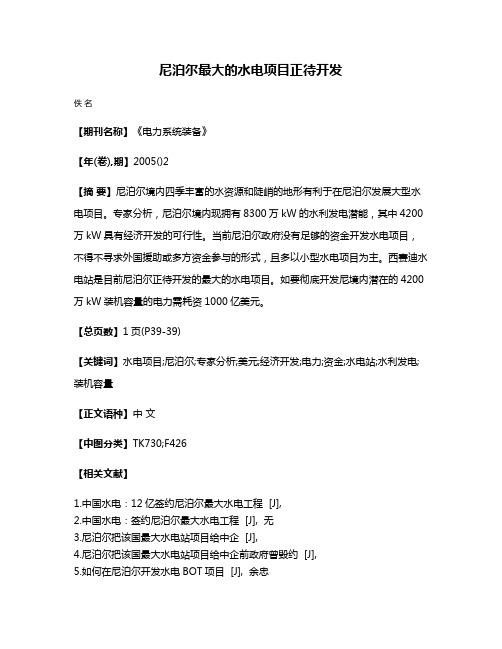
尼泊尔最大的水电项目正待开发
佚名
【期刊名称】《电力系统装备》
【年(卷),期】2005()2
【摘要】尼泊尔境内四季丰富的水资源和陡峭的地形有利于在尼泊尔发展大型水电项目。
专家分析,尼泊尔境内现拥有8300万kW的水利发电潜能,其中4200万kW具有经济开发的可行性。
当前尼泊尔政府没有足够的资金开发水电项目,不得不寻求外国援助或多方资金参与的形式,且多以小型水电项目为主。
西赛迪水电站是目前尼泊尔正待开发的最大的水电项目。
如要彻底开发尼境内潜在的4200万kW装机容量的电力需耗资1000亿美元。
【总页数】1页(P39-39)
【关键词】水电项目;尼泊尔;专家分析;美元;经济开发;电力;资金;水电站;水利发电;装机容量
【正文语种】中文
【中图分类】TK730;F426
【相关文献】
1.中国水电:12亿签约尼泊尔最大水电工程 [J],
2.中国水电:签约尼泊尔最大水电工程 [J], 无
3.尼泊尔把该国最大水电站项目给中企 [J],
4.尼泊尔把该国最大水电站项目给中企前政府曾毁约 [J],
5.如何在尼泊尔开发水电BOT项目 [J], 余忠
因版权原因,仅展示原文概要,查看原文内容请购买。
'火电厂热电厂各系统中英文对照'doctypedoc
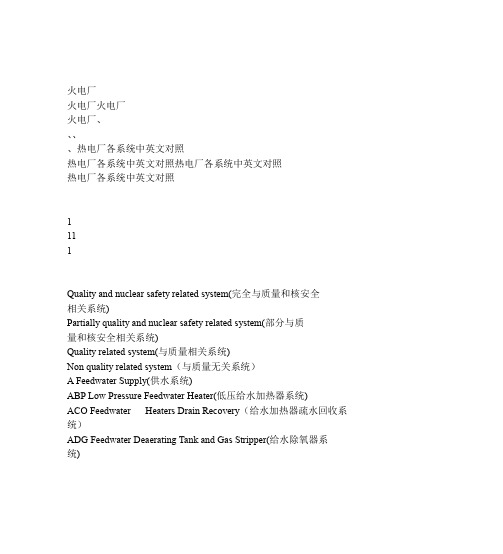
火电厂火电厂火电厂火电厂、、、、热电厂各系统中英文对照热电厂各系统中英文对照热电厂各系统中英文对照热电厂各系统中英文对照1111Quality and nuclear safety related system(完全与质量和核安全相关系统)Partially quality and nuclear safety related system(部分与质量和核安全相关系统)Quality related system(与质量相关系统)Non quality related system(与质量无关系统)A Feedwater Supply(供水系统)ABP Low Pressure Feedwater Heater(低压给水加热器系统)ACO Feedwater Heaters Drain Recovery(给水加热器疏水回收系统)ADG Feedwater Deaerating Tank and Gas Stripper(给水除氧器系统)ADS LV AC Network 380V(ET Buiding)/低压交流电源380V系统(ET厂房)AET Feedwanter Pump Turbine Gland(主给水泵汽机轴封系统)AGM Moter Driven Feedwater Pump Lubrication(电动主给水泵润滑系统)AGR Feedwater Pump Turbine Lubrication and Control Fluid(主给水泵汽机润滑油及调节油系统)AHP High Pressure Feedwataer Heater(高压给水加热器系统) ory System(汽机监视系统)APA Moter-Driven Feedwater Pump(电动主给水泵系统)2222APD Start-up Feedwater System(启动给水系统)APG Steam Generator Blowdown(蒸汽发生器排污系统)APP Turbine-Driven Feedwater Pump(汽动主给水泵系统)APU Feedwater Pump Turbine Drain(主给水泵汽机疏水系统)ARE Feedwater Flow Control(给水流量控制系统)ASG Auiliary Feedwater (辅助给水系统)ATE Condensate Polishing Plant(凝结水净化处理系统)C Condenser(Condensation-Vacuum-Circulating Water)/凝汽器(冷凝-真空-循环水)CAR Turbine Exhaust Water Spraying(汽机排汽口喷淋系统)CET Turbine Gland(汽机轴封系统)CEX Condensate Extraction(凝结水抽取系统)CFI Circulating Water Filtraation(循环水过滤系统)CGR Circulating Water Pump Lubrication(循环水泵润滑系统)CPA Cathodic Protection(阴极保护系统)CRF Circulating Water(循环水系统)3333CTE Circulating Water Treatment(循环水处理系统)CVI Condenser Vacuum(凝汽器真空系统)D Ventilation-Handling Equipment-Communications-Elighting(通风-吊装设备-通讯-照明)DAA BOP Elevator System(BOP电梯系统)DAI Nuclear Island Building Elevators(核岛厂房电梯)DAM Turbine Hall Elevators(汽机厂房电梯)DEG Nuclear Island Chilled Water (核岛冷冻水系统)DEL Electrical Building Chilled Water(电气厂房冷冻水系统)DMA BOP Handling Equipment(AC Building)/BOP吊装设备(AC厂房)DME Main Swithchyard Handling Equipment(主开关站吊装设备)DMH Miscellaneous Hoists and Lifting Equipment in BOP Buildingsand Area(BOP厂房和BOP区域内的各种吊装设备DMK Fuel Building Handling Equipment(核燃料厂房吊装设备)DMM Turbine Hall Mechanical Handling Equipment(汽机厂房机械吊装设备)DMN Nuclear Auxiliary Building Handling Equipment(核辅助厂房吊装设备)4444DMP Circulating Water Pumping Station Handling Equipment (循环水泵站吊设备)DMR Reactor Building Handling Equipment(反应堆厂房吊装设备)DMW Handling Equipment for Reactor Building Gantry andPeripheral Rooms(反应堆厂房外部龙门架及其外围厂房吊装设备) DNB BOP Building&Area Normal Lighting(BOP厂房和区域内正常照明系统)DNK Fuel Buildings Normal Lighting(核燃料厂房正常照明系统)DNL Electrical Building Nomal Lighting(电气厂房正常照明系统)DNM Turbine Hall Normal Lighting(汽机厂房正常照明系统)DNN Nuclear Auxiliray Building Normal Lighting(核辅助厂房正常照明系统)DNP Circulating Water Pumping Station Normal Lighting(循环水泵房正常照明系统)DNQ Waste Auxiliary Building Normal Lighting(核废料辅助厂房正常照明系统)DNR Reactor Building Normal Lighting(反应堆厂房正常照明系统)DSB BOP Building&Area Emergency Lighting(BOP厂房和区域内应急照明系统)DSI Site Security System(厂区保安系统)DSK Fuel Buildings Emergency Lighting(核燃料厂房应急照明系统)5555DSL Electrical Building Emergency Lighting (电气厂房应急照明系统)DSM Turbine Hall Emergency Lighting(汽机厂房应急照明系统)DSN Nuclear Auxiliray Building Emergency Lighting(核辅助厂房应急照明系统)tem(汽机监视系统)DSP Circulating Water Pumping Station Emergency Lighting(循环水泵房应急照明系统)DSQ Waste Auxiliary Building Emergency Lighting(核废料辅助厂房应急照明系统)DSR Reactor Building Emergency Lighting(反应堆厂房应急照明系统)DTL Closed-Circuit Television(闭路电视系统)DTV Site Communication(厂区通讯系统)DVC Control Room Air Conditioning(主控制室空调系统)DVE Cable Floor Ventilation (电缆层通风系统)DVF Electrical Building Smoke Exhaust(电气厂房排烟系统)DVG Auxiliary Feedwater Pump Room Ventilation(辅助给水泵房通风系统)DVH Charging Pump Room Emergency Ventilation(上充泵房应急通风系统)DVI Component Cooling Room Ventilation(设备冷却水房间通风系统)DVK Fuel Building Ventilation(核燃料厂房通风系统)6666DVL Electrical Building Main Ventilation(电气厂房主通风系统)DVM Turbine Hall Vetilation(汽机厂房通风系统)DVN Nuclear Auxiliry Building Ventilation?房应急照明系统)统)DVP Circulating Water Pumping Station Ventilation (循环水泵通风系统)DVQ Waste Auxiliary Building Ventilation (废物辅助厂房通风系统)DVS Safety Injection and Containment Spray Pump Motor RoomVentilation(安全注入和安全喷林泵电机通风系统)DVT Demineralization Plant VentilationDVV Auxiliary Boiler and Compressor Building Ventilation(辅助锅炉和空压机厂房通风系统)DVW Peripheral Rooms Ventilation (安全壳环廊房间通风系统)DVX Lubricating Oil Transfer Plant Building Ventilation(润滑油输送装置厂房通风系统)DW A Hot Workshop and Warehouse Ventilation(热机修车间和仓库通风系统)DWB RestaurantVentilation (SA餐厅通风系统)DWC Trainning Center Ventilation (EA Building)/培训中心通风系统DWD Security Building Ventilation(保安楼通风系统)7777DWE Main Swithchyard Ventilation(主开关站通风系统)DWM EC Building Ventilation System(EC厂房暖通空调系统)ets(集中控制模拟量机柜)DWL Hot Laundry Ventilation(热洗衣房通风系统)DWM Emergency Center Ventilation System(应急中心通风系统/EM楼)DWN Site Laboratory Ventilation(厂区实验室通风系统/AL实验室)DWQ Garge & Laundry Ventilation(车库和洗衣房通风系统(AG/EL)厂房)DWS Essential ServiceWater Pumping Station Ventilation(重要厂用水泵站通风系统/PX泵站)DWT Archive & Documentation Center Ventilation(AD Building )/文档中心通风系统(AD楼)DWU Fire Fighting Training CenterV entilation(消防培训中心通风系统/EB楼)DWV Oil Storage Area V entilation (FC Building)/油料仓库通风系统(FC厂房)DWX Compressors Building Ventilation System(ZC Building)/空压机房通风系统(ZC厂房)DWY Electrochlorination Plant Ventilation(制氯站通风系统)DWZ Hydrogen Production Plant Ventilation(制氢站通风系统)8888E ContainmentEAS Containment Spray(安全壳喷淋系统)lation System(EC厂房暖通空调?rEAU Containment Instrumentation(安全壳仪表系统)EBA Containment Sweeping Ventilation(安全壳换气通风系统)EPP Containment Leakage Monitoring(安全壳泄漏监测系统)ETY Containment Atmosphere Monitoring(安全壳大气监测系统)EVC Reactor Pit Ventilation(反应堆堆坑通风系统)EVF Containment Cleanup(安全壳内空气净化系统)EVR Containment Continuous Ventilation(安全壳连续通风系统)G Turbine Generator(汽轮发电机)GCA Turbine and Feedheating Plant Preservation DuringOutage(汽机和给水加热装置停运期间的保养系统)GCT Turbine Bypass(汽机旁路系统)GEV Power Transmission(输电系统)GEW Main Swithchyard-EHV Switchgear(主开关站-超高压配电装置)GEX Generator Excitation and V oltage Regulation(发电机励磁和电压调节系统)9999GFR Turbine Control Fluid(汽机调节系统)GGR Turbine Lubrication Jaching and Turning(汽机润滑、顶轴和盘车系统)GHE Generator Seal Oil(发电机密封油系统)GME Turbine Supervisory System(汽机监视系统) GPA Generator and Power Transmission Protection(发电机和输电保护系统)GPV Turbine Steam and Drain(汽机蒸汽和疏水系统)GRE Turbine Governing(汽机调节系统)GRH Generator Hydrogen Cooling(发电机氢气冷却系统)GRV Generator Hydrogen Supply(发电机氢气供应系统)GSE Turbine Protection(汽机保护系统)GSS Moisture Separator Water(汽水分离再热器系统)GST Stator Cooling Water(发电机定子冷却水系统)GSY Grid Synchronization and Connection(同步并网系统)GTH Turbine Lube Oil Treatment(汽机润滑油处理系统)GTR TurbineGenerator Remote Control(汽轮发电机远程控制系统)10101010J Fire Protection(Detection-Fire Fighting)/消防(探测-火警)JDT Fire Detection(火警探测系统)JPD Fire Fighting Water Distribution(消防水分配系统)JPH Turbine Oil Tank Fire Protection(汽机油箱消防系统)JPI Nuclear Island Fire Protection (核岛消防系统)JPL Electrical Building Fire Protection(电气厂房消防系统)JPP Fire Fighting Water Production(消防水生产系统)JPS Mobile & Portable Fire Fighting Equipment(移动式和便携式消防设备)JPT Transformers Fire Protection(变压器灭火系统)JPU Site Fire Fighting Water Distribution(厂区消防水分配系统)JPV DieselGenerator Fire Protection(柴油发电机灭火系统)K Instrumentation and Control(仪表和控制)KBS Thermocouple Cold Junction Boxes(热电偶冷端盒系统)KCO Common Control Cabinets for Conventional Island(常规岛共用控制机柜)KDO Test Data Acquisition(试验数据采集系统)11111111KIR Loose Parts and Vibration Monitoring(松动部分和振动监测系统)KIS Seisimic Instrumentation(地震仪表系统)KIT Centralized Data Processing(集中数据处理系统)KKK Site and Building Access Control(厂区和办公楼出入监督系统)KKO Energy Metering and Perturbography(电度表和故障录波仪)KLP 500KV Line Protection 500KV (线路保护系统)KME Test Instrumentation(试验仪表系统)KPR Remote Shutdown Panel (应急停堆盘系统)KRG General Control Analog Cabinets(集中控制模拟量机柜)?房应急照明系统)KRS Site Radiation and Meteorological Monitoring(厂区辐射与气象检测系统)KRT Plant Radiation Monitoring (电厂辐射监测系统)KSA Alarm Processing(报警处理系统)KSC Main Control Room(主控制室系统)KSN Nulear Auxiliary Building-Local Control Panels and Boards(核辅助厂房-就地控制屏和控制盘)12121212KSU Security Building Control Desk(应急保安控制台系统)KZC Controlled Area Access Monitoring(控制区出入监测系统)L Electrical System(电气系统)LAA Uninterrupted 230V DC Power System(LNE)Inverter Power Supply/230V 不间断直流电源系统、逆变系统(电气厂房LNE)LAB Turbine Generator Continuous Lubrication Pump Power Supply/汽轮机不间断润滑油泵电源系统(汽机厂房)常?JPD Fire Fightin_。
- 1、下载文档前请自行甄别文档内容的完整性,平台不提供额外的编辑、内容补充、找答案等附加服务。
- 2、"仅部分预览"的文档,不可在线预览部分如存在完整性等问题,可反馈申请退款(可完整预览的文档不适用该条件!)。
- 3、如文档侵犯您的权益,请联系客服反馈,我们会尽快为您处理(人工客服工作时间:9:00-18:30)。
尼泊尔电力系统状况-
-中英文
精品好文档,推荐学习交流
3.3.1 电力系统现状
从发电角度来看,尼泊尔可被称为“水电国家”。
作为一个没有石油储量的内陆国家,现实情况是,在狭窄宽度约 100 km 的范围内,海拔高度从8840 m 至不到 100 m。
冰和融雪水不断地为河流提供可靠的水源。
但是,水电的开发很有限。
理论上的水电蕴藏量有 83290 MW,但是到现在为止只开发了554 MW。
尼泊尔有四大河流流域:最西部地区的马哈卡利一格尔纳利流域,西部地区的根德格流域,中部和东部地区的撒普特一科西流域,以及南部的河流流域。
把尼泊尔的水电作为该地区的高峰用电是非常划算的。
技术上可行的水电蕴藏量有48 000MW,蓄水工程可发电约 52%大约 23 000 MW 是水电。
尼泊尔的国内电力市场,每年高峰电力需求增长 8%,到 2010 年容量需求达到857 MW,预计到 2020 年将达到 1 820 MW。
但系统负荷曲线峰值突出,约是基荷的 2.5 倍。
为满足电力需求建设光伏发电项目是有必要的。
经勘测光伏发电总装机量为10MW和当地电网匹配,本项目装机容量不会对电网的安全运行产生影响。
3.3.1 Current Situation of Power System
From the perspective of electric-power generation, Nepal can be called “hydroelectric power country”. As an inland country with no petroleum reserves, the fact is, in the narrow width of the range of about 100 km, the altitude varies from 8840m to less than 100m. Ice and snow melt water continuously providing reliable supply for the rivers. However, the development of hydroelectric power is limited. The hydroelectric power reservation in theory is 83290 MW, but so far only 554 MW has been developed. Nepal has four major river basins: Mahathir马哈卡利Mahakali一格尔纳利Karnali river basin in the most western region, 根德格Gandak river basin in the west,撒普特科西Sapta Kosi river basin in the central and eastern part, and the river basin in the south part. It is quite cost-effective to utilize the hydroelectric power as power resource during peak hours in the region. The technically feasible hydropower reserves are 48 000MW,water storage projects could generate about 52%, and of which 23000MW is hydropower.On the domestic electricity market in Nepal, the peak-hour power demand increased by 8% every year, so far until 2010 the capacity demand has reached 857MW, and it is estimated that the demand will grow to 1820MW.But the curve peak of system load is prominent, it is about 2.5 times as much as that of the base load. It is necessary to build photovoltaic power projects to meet the demands of electric power. After a survey, the general capacity of photovoltaic power generation is10MW, which matches the local power grid, the installed capacity of this project will not affect the safe operation of the grid.
仅供学习与交流,如有侵权请联系网站删除谢谢1。
